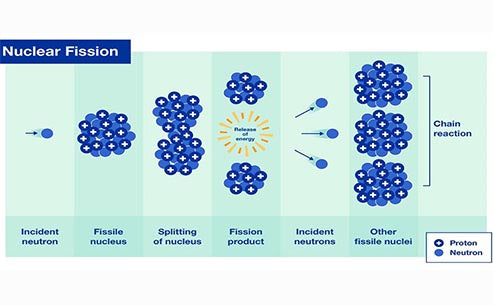
main content:
Before nuclear energy was discovered and used, the main energy sources used by mankind were chemical energy and water energy. From the end of the nineteenth century to the beginning of the twentieth century, physics has been greatly developed. Humankind's understanding of the structure of matter has begun to penetrate to the level of atoms and even more microscopic particles, which objectively laid the foundation for human use of nuclear energy. Nuclear energy not only consumes a small amount of nuclear fuel to produce huge amounts of energy, but the use of nuclear energy can also save a lot of coal and oil, and greatly reduce the amount of transportation.
Nuclear energy is an important development direction of energy. Especially in the transition period of the world's energy structure from oil-based to non-oil energy, nuclear energy, coal and energy conservation are considered to be the main hopes for solving the energy crisis. The development of nuclear energy technology will have a profound impact on modern society.
Introduction to Nuclear Energy
Nuclear energy, also known as atomic energy, is the energy released by changing its mass from the nucleus and the internal structure of the nucleus. Its law conforms to Albert Einstein’s equation E=mc², where E stands for energy and m stands for mass. c represents the constant of the speed of light.
Nuclear energy usually releases its energy through one of three nuclear reactions:
(1) Nuclear fission that opens the binding force of atomic nuclei, such as fission of uranium;
(2) Nuclear fusion in which atomic particles are fused together, such as the fusion of deuterium, tritium, and lithium;
(3) Nuclear decay in the form of natural and much slower fission, such as the decay of radioactive elements.
Nuclear energy has great power. The energy released by the fission of 1 kilogram of uranium nucleus is approximately equal to the chemical energy released by the combustion of 2,700 tons of standard coal. A 1 million kilowatt nuclear power plant requires only 25 to 30 tons of low-concentration uranium nuclear fuel per year, while a coal power plant of the same power requires more than 3 million tons of raw coal each year. These nuclear fuels can be transported to the site with only 10 trucks. To transport more than 3 million tons of coal, 1,000 trains are required. The energy released by nuclear fusion reactions is even more valuable. Someone has made a vivid analogy. 1 kilogram of coal can only make a train travel 8 meters, 1 kilogram of uranium can make a train travel 40,000 kilometers; and 1 kilogram of a mixture of lithium tritide and deuterium than lithium can make a train travel from the earth. Drive to the moon, a distance of 400,000 kilometers. The earth contains a considerable amount of nuclear fission resources such as uranium and thorium. If their fission energy is fully utilized, it can meet the energy needs of mankind for thousands of years. In the vast ocean, there are 20 trillion tons of deuterium, and their fusion energy can reach several trillion tons of coal, which can meet the energy needs of mankind for tens of billions of years.
1. The source of nuclear energy

There are relatively abundant nuclear resources in the world. Nuclear fuels include uranium, thorium, deuterium, lithium, boron, etc. The world's reserves of uranium are about 4.17 million tons. The nuclear fuel resources available for development on the earth provide more than 100,000 times the energy of fossil fuels.
(1) Uranium is a high-energy nuclear fuel, and is currently the fuel commonly used by nuclear power plants and nuclear weapons worldwide. Uranium reserves on land are not abundant, and the distribution is extremely uneven. According to the International Atomic Energy Agency's estimate of 16.2 million tons of conventional uranium resources in the world, the current consumption capacity can last for 250 years. Countries with large uranium resources in the world include Australia, Kazakhstan, the United States, Canada, South Africa, Niger, Namibia, Russia, Brazil, and Ukraine. Their uranium resources are all over 100,000 tons, accounting for 88.1% of the world's uranium resources. . In a huge body of sea water, it is rich in uranium resources. It is estimated that the amount of uranium dissolved in seawater can reach 4.5 billion tons, which is equivalent to several thousand times the total reserves on land. If all the uranium in seawater can be extracted, the fission energy contained can guarantee the energy needs of mankind for tens of thousands of years.
(2) Deuterium and tritium are both isotopes of hydrogen. As long as there is water, there are deuterium and tritium. It is estimated that each liter of seawater contains 0.03 grams of deuterium, and the energy released when 0.03 grams of deuterium fusion is equivalent to the energy of 300 liters of gasoline burning. There are hundreds of millions of billions of kilograms of deuterium in the huge ocean waters on the earth. The energy released by the fusion of deuterium is enough to guarantee human energy consumption for tens of billions of years. Moreover, the extraction method of deuterium is simple and low in cost.
(3) "Energy metal" lithium is an important raw material for making hydrogen bombs. The ocean contains 15-20 mg of lithium per liter of seawater, and the total lithium reserves in the seawater are about 250 billion tons.
(4) After analyzing the lunar soil samples brought back from the moon, scientists estimated that the moon holds about 500 million tons of helium-3, which is enough for humans to use for thousands of years if it is used as an alternative energy source for humans.
2. The main features of nuclear energy

Nuclear energy has the following two major characteristics.
First of all, nuclear energy has a high energy density. Consuming a small amount of nuclear fuel can produce huge energy, and the energy released by fission of U-235 per kilogram is equivalent to the energy released by burning 2500 high-quality coal. For nuclear power plants, only a small amount of nuclear fuel is consumed to generate a large amount of electricity. For example, a 1 million kW thermal power plant consumes 300-400t of coal per year, while a nuclear power plant of the same power only needs 30-40t of nuclear fuel per year. With the same quality, nuclear energy is several million times larger than chemical energy.
Secondly, the reaction rate of nuclear energy is fast. We can understand the reaction rate of nuclear energy from the explosion of the atomic bomb. We all know that the explosion of an atomic bomb will produce a mushroom cloud because of the huge energy produced by nuclear energy in an instant. The huge energy generated by the atomic bomb at the moment of explosion sharply compresses the air around it to form a pressure difference, resulting in the formation of a strong air flow. The "mushroom cloud" produced by the atomic bomb during the explosion illustrates this point.
3. The superiority of nuclear energy

The application of nuclear energy as a cost-effective measure to alleviate the world energy crisis has many advantages.
1. Nuclear fuel has many advantages, such as small size and high energy. Nuclear energy is millions of times larger than chemical energy; the energy released by 1,000 grams of uranium is equivalent to the energy released by 2,700 tons of standard coal; a large coal-fired power station with a capacity of 1 million kilowatts , 3 to 4 million tons of raw coal are needed every year to transport this coal requires 2,760 trains, which is equivalent to 8 trains a day, and 40 million tons of ash. A pressurized water reactor nuclear power plant of the same power consumes only 28 tons of low-enriched uranium fuel with a uranium content of 3% a year; the cost per pound of uranium is about US$20, which is about US$0.001 when converted to 1 kilowatt. The current cost of traditional power generation is much cheaper; moreover, due to the small transportation volume of nuclear fuel, nuclear power plants can be built near the industrial areas where they are most needed. The capital construction investment of a nuclear power plant is generally one and a half to two times that of an equivalent thermal power plant, but its nuclear fuel costs are much cheaper than coal, and the operation and maintenance costs are also less than that of a thermal power plant. If you have mastered the nuclear fusion reaction technology, use sea water. As fuel, it is inexhaustible and convenient to use.
2. There is relatively little pollution in the application of nuclear energy, which is a kind of clean energy. Thermal power stations continue to emit harmful substances such as sulfur dioxide and nitrogen oxides into the atmosphere. At the same time, a small amount of radioactive materials such as uranium, titanium and radium in coal will also fall to the surrounding thermal power stations with smoke and dust, polluting the environment. However, nuclear power plants have set up layers of barriers, and basically do not emit environmentally polluting substances. Even radioactive pollution is much less than that of coal-fired power plants. According to statistics, when a nuclear power plant is operating normally, the radioactive impact on residents in a year is less than the dose received by X-ray fluoroscopy.
Scholars have conducted comparative studies on the environmental impact of my country's coal power chain and nuclear power chain in the mid-1990s. The coal power chain refers to coal mining, coal washing, transportation, power generation, and the utilization and disposal of waste residues; the nuclear power chain refers to uranium mining, hydrometallurgy, transformation, enrichment, component manufacturing, power generation, post-processing, and waste disposal. The coal power chain is based on the national average in the mid-1990s; the value of natural uranium mining and extraction in the nuclear power chain is based on the national average. The results of the comparative study are as follows.
(1) Impact on public health. From the perspective of radiation exposure to the public, the coal power chain is 420 people Sv (Gwea)-1, and the nuclear power chain is 8.39 people Sv (Gwea)-1; the coal power chain is about 50 times that of the nuclear power chain. In terms of non-radiation, using the health hazard assessment method, the coal power chain is 12 people (Gwea)-1, the nuclear power chain is 0.67 people (Gwea)-1, and the coal power chain is one order of magnitude higher than the nuclear power chain.
(2) Impact on the environment. Under normal circumstances, the coal-fired power chain can observe the obvious impact of SO2 and NOX emissions on forests and crops. According to the research results of the project "Acid rain deposition and its impact on the ecological environment in my country", in 1993, acid rain and SO2 caused economic losses of 3.7 billion yuan in crops and 6 billion yuan in forests in Jiangsu and other seven eastern provinces. In 1995, the acid deposition of SO2 emissions caused economic losses of 99.3 billion yuan to crops and forests across the country; if the harm to human bodies, buildings, bridges and equipment are added, the losses would be even greater. With the exception of the Chernobyl accident, no perceptible impact was found on the nuclear power chain. The solid waste covers an area of approximately 2.1×104m² (Gwea)-1 for the coal power chain, 1×104m² (Gwea)-1 for the nuclear power chain; surface subsidence: 1106m² (Gwea)-1 for the coal power chain, and only 1106m² (Gwea)-1 for the nuclear power chain 1.6×102m² (Gwea) -1.
According to the results of the "Communiqué on Major Pollutant Emissions in the First Half of 2008 by Provinces, Autonomous Regions and Municipalities in the First Half of 2008" issued by the State Environmental Protection Administration, the National Bureau of Statistics, and the National Development and Reform Commission, the total national SO2 emissions were 12.133 million tons, and the total chemical oxygen demand emissions 6.742 million tons. In contrast, nuclear power emits much less waste to the environment, about one tens of thousands of that of coal power. It does not emit SO2, benzopyrene, nor does it produce dust or ash. It is the energy source that emits the least greenhouse gas, and it is also an economical and effective means to reduce greenhouse gas emissions. The 30-year radiation environmental quality assessment of the nuclear industry in my country shows that the collective dose of the nuclear industry to the residents within the assessment range is less than 1/10000 of the natural radiation dose received by the residents in the same range. The doses received by key residents around nuclear facilities (referring to the largest dose received) are basically less than 1/10 of the natural background. Qinshan and Daya Bay nuclear power plants are less than 1/100. This shows that nuclear energy is an environmentally friendly green energy source.
3. The safety of nuclear energy applications is strong. Since the completion of the first nuclear power plant, more than 400 nuclear power plants have been put into operation in the world. They have been basically safe and normal for more than 30 years, although there were the accident of the Three Mile Island PWR nuclear power plant in the United States in 1979 and the Chernobyl graphite in the Soviet Union in 1986. Boiling water reactor nuclear power plant accident, but both accidents were caused by human factors. With further improvements in pressurized water reactors, nuclear power plants may become safer.
















